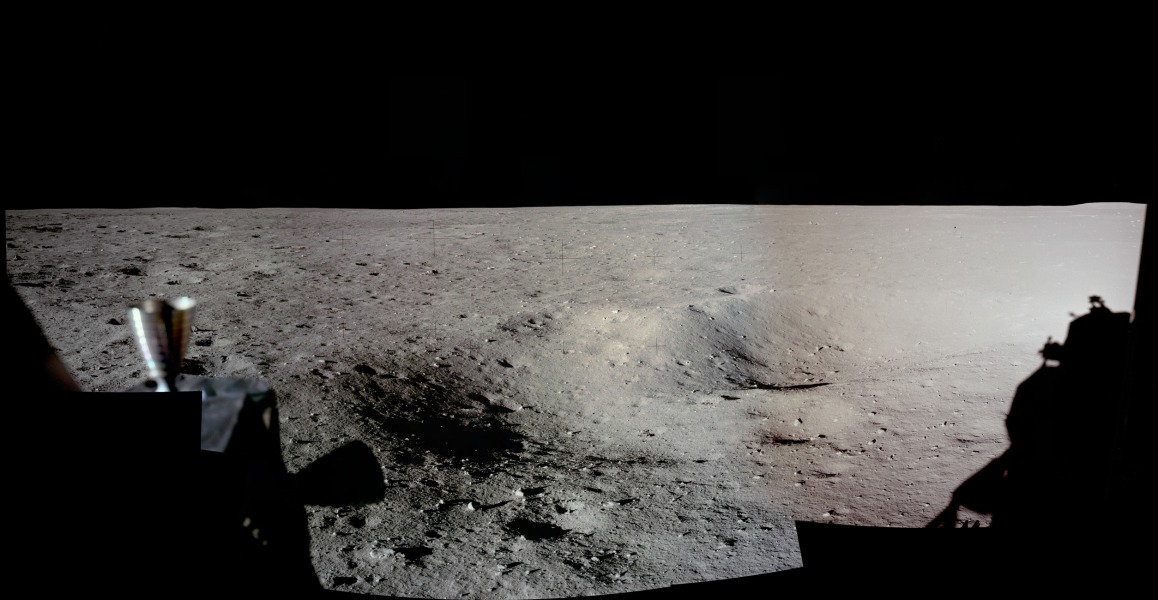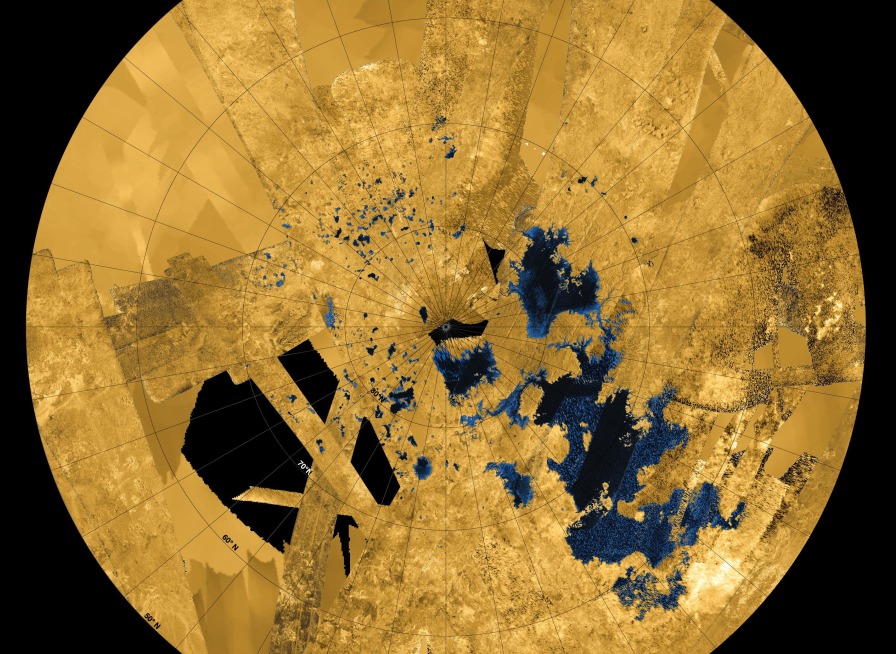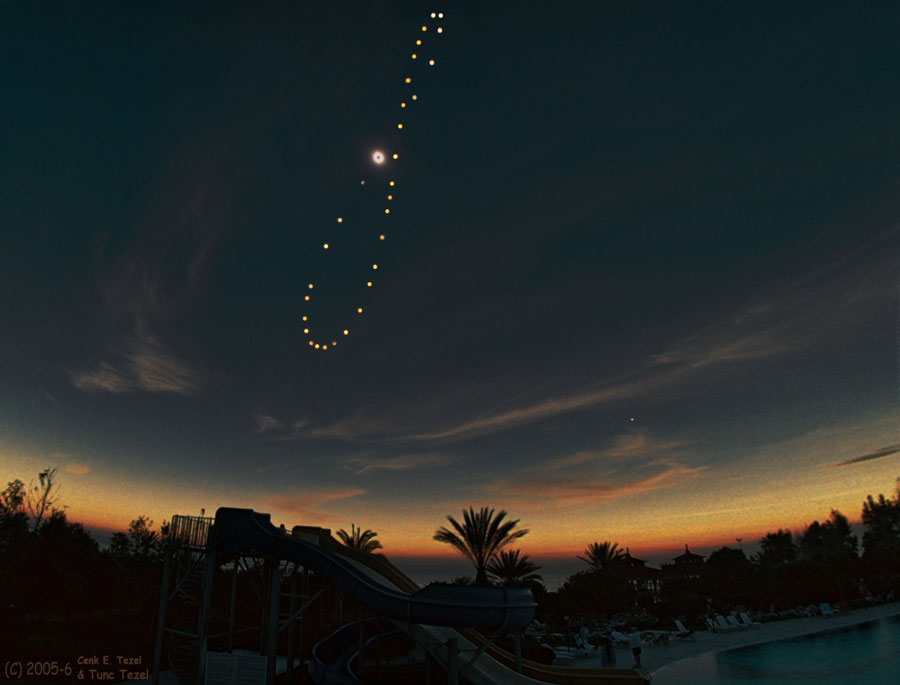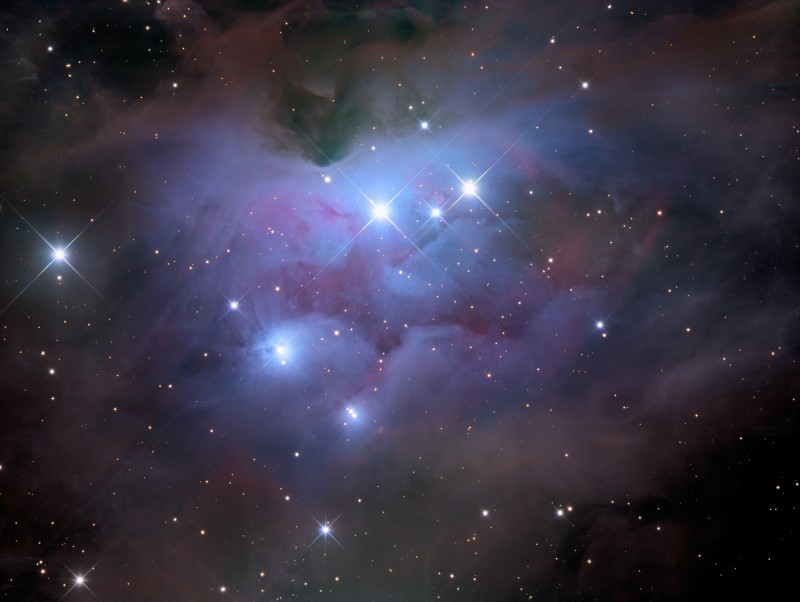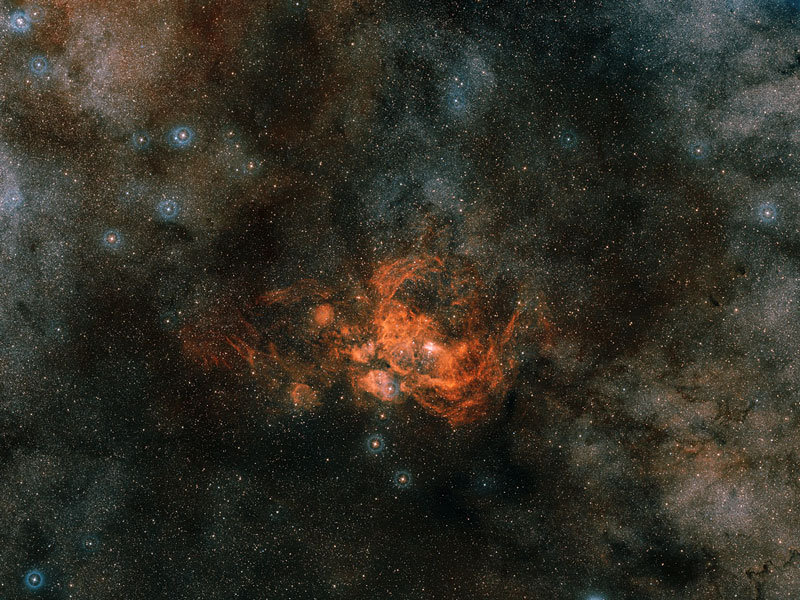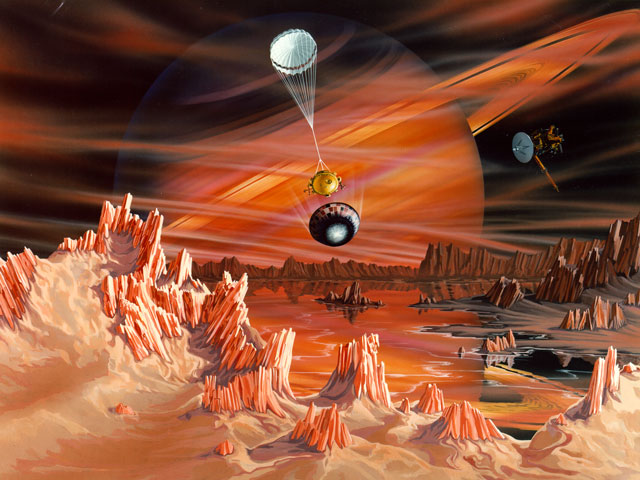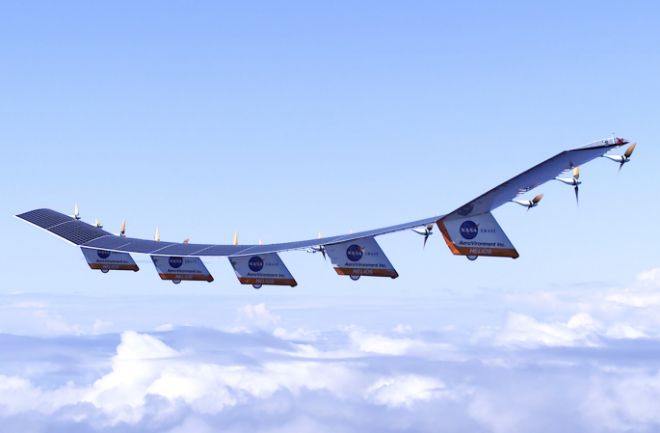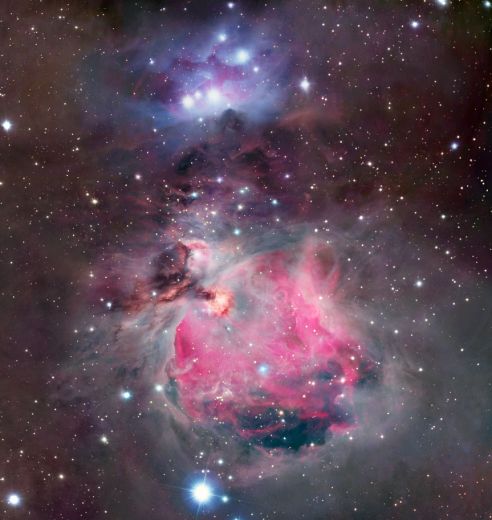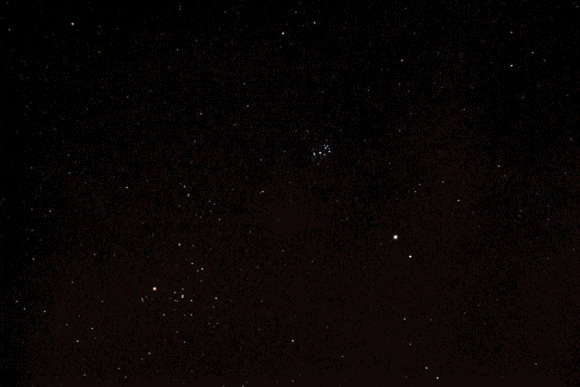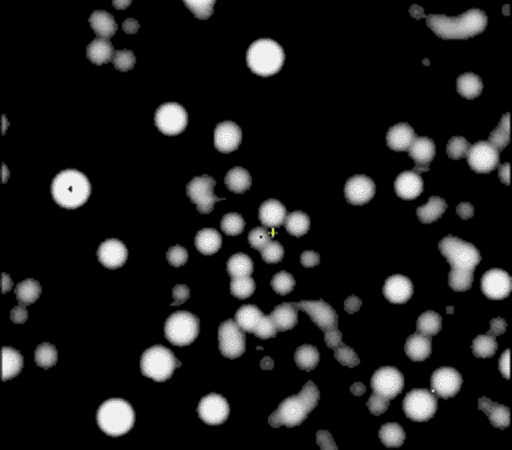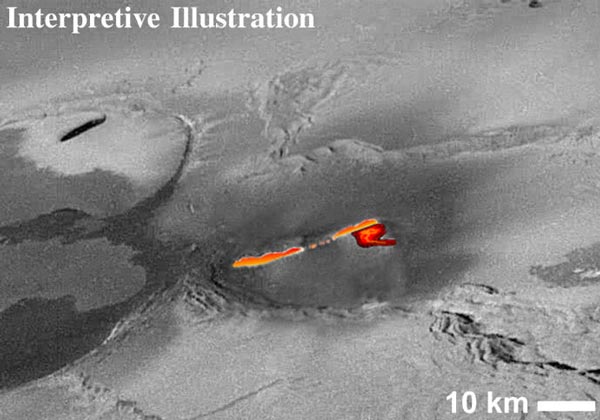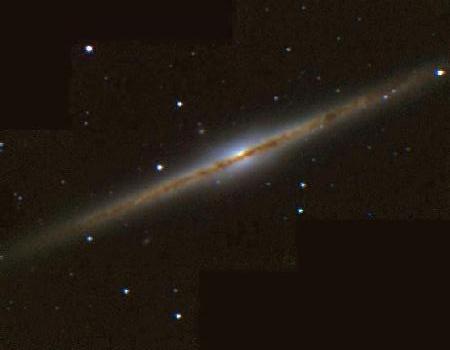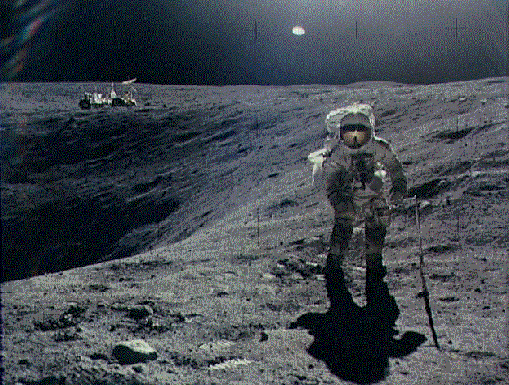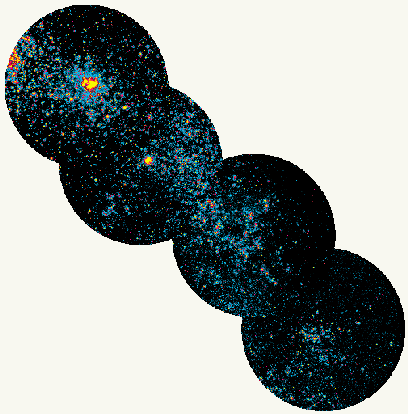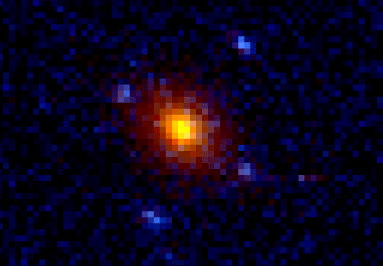| << Previous | Index | Next >> |
2014 Have you seen a panorama from another world lately? Assembled from high-resolution scans of the original film frames, this one sweeps across the magnificent desolation of the Apollo 11 landing site on the Moon's Sea of Tranquility. Taken by Neil Armstrong looking out his window of the Eagle Lunar Module, the frame at the far left (AS11-37-5449) is the first picture taken by a person on another world. Toward the south, thruster nozzles can be seen in the foreground on the left, while at the right, the shadow of the Eagle is visible toward the west. For scale, the large, shallow crater on the right has a diameter of about 12 meters. Frames taken from the Lunar Module windows about an hour and a half after landing, before walking on the lunar surface, were intended to initially document the landing site in case an early departure was necessary.
2013 Saturn's large moon Titan would be unique in our solar system, the only world with stable liquid lakes and seas on its surface ... except for planet Earth of course. Centered on the north pole, this colorized map shows Titan's bodies of methane and ethane in blue and black, still liquid at frigid surface temperatures of -180 degrees C (-292 degrees F). The map is based on data from the Cassini spacecraft's radar, taken during flybys between 2004 and 2013. Roughly heart-shaped, the lake above and right of the pole is Ligeia Mare, the second largest known body of liquid on Titan and larger than Lake Superior on Earth. Just below the north pole is Punga Mare. The sprawling sea below and right of Punga is the (hopefully sleeping) Kraken Mare, Titan's largest known sea. Above and left of the pole, the moon's surface is dotted with smaller lakes that range up to 50 kilometers across.
2012
2011 NGC 253 is not only one of the brightest spiral galaxies visible, it is also one of the dustiest. Discovered in 1783 by Caroline Herschel in the constellation of Sculptor, NGC 253 lies only about ten million light-years distant. NGC 253 is the largest member of the Sculptor Group of Galaxies, the nearest group to our own Local Group of Galaxies. The dense dark dust accompanies a high star formation rate, giving NGC 253 the designation of starburst galaxy. Visible in the above photograph is the active central nucleus, also known to be a bright source of X-rays and gamma rays.
2010
[imghover6=http://apod.nasa.gov/apod/image/1012/so ... riguss.jpg]http://apod.nasa.gov/apod/image/1012/so ... otated.jpg[/imghover6]Credit & Copyright: Jerry Lodriguss (Catching the Light)
2009 If you went outside at exactly the same time every day and took a picture that included the Sun, how would the Sun appear to move? With great planning and effort, such a series of images can be taken. The figure-8 path the Sun follows over the course of a year is called an analemma. This coming Tuesday, the Winter Solstice day in Earth's northern hemisphere, the Sun will be at the bottom of the analemma. Analemmas created from different latitudes would appear at least slightly different, as well as analemmas created at a different time each day. With even greater planning and effort, the series can include a total eclipse of the Sun as one of the images. Pictured is such a total solar eclipse analemma or Tutulemma - a term coined by the photographers based on the Turkish word for eclipse. The composite image sequence was recorded from Turkey starting in 2005. The base image for the sequence is from the total phase of a solar eclipse as viewed from Side, Turkey on 2006 March 29. Venus was also visible during totality, toward the lower right.
2008 Tomorrow's solstice marks the southernmost point of the Sun's annual motion through planet Earth's sky and the astronomical beginning of winter in the north. In celebration of the northern winter solstice and the International Year of Astronomy 2009, you can watch a live webcast of the the solstice sunrise from the megalithic tomb of Newgrange, in County Meath, Ireland. Newgrange dates to 5,000 years ago, much older than Stonehenge, but also with accurate alignments to the solstice Sun. In this view from within the burial mound's inner chamber, the first rays of the solstice sunrise are passing through a box constructed above the entrance and shine down an 18 meter long tunnel to illuminate the floor at the foot of a decorated stone. The actual stone itself would have been directly illuminated by the solstice Sun 5,000 years ago. The long time exposure also captures the ghostly figure of a more modern astronomer in motion. To watch the live webcast follow the indicated link below. The webcast is planned to go live at 0830 coordinated Universal Time (for example, at 3:30am Eastern Time in the US) tomorrow, Sunday, the 21st.
2007 The 1970s are sometimes ignored by astronomers. In particular, this beautiful grouping of reflection nebulae in Orion - NGC 1977, NGC 1975, and NGC 1973 - are usually overlooked in favor of the substantial glow from the nearby stellar nursery better known as the Orion Nebula. Found along Orion's sword just north of the bright Orion Nebula complex, these reflection nebulae are also associated with Orion's giant molecular cloud about 1,500 light-years away, but are dominated by the characteristic blue color of interstellar dust reflecting light from hot young stars. North is down in this sharp color telescopic image from New South Wales, Australia, so the more familiar Orion Nebula borders the top of the view. NGC 1977 stretches across the field just above center, separated from NGC 1973 (below left) and NGC 1975 (below right) by darker regions of obscuring dust. Many northern hemisphere observers claim to see the general shape of a running man in the cosmic dust cloud but, of course, they're looking at the view upside down.
2006
2005 Is there a road to the stars? Possibly there are many, but the physical road pictured above leads up to the top of a dormant volcano that is a premier spot on planet Earth for observing stars and astronomical phenomena. At the top of Hawaii's Mauna Kea are some of the largest optical telescopes on Earth, including the Keck telescopes, Gemini, Subaru, CFHT, and the IRTF. Together, these 10-meter eyes have made many universe-redefining discoveries, including detailing that most of the universe is made not of familiar matter but of mysterious dark matter and dark energy. The above picture was compiled from over 150 one-minute exposures from a digital camera. During that time, the rotation of the Earth made the stars far in the distance appear to have long star trails. The foreground landscape was illuminated by the Moon.
2004 What does the surface of Titan look like? Thick clouds have always made Saturn's largest moon so mysterious that seemingly farfetched hypotheses like methane rain and lakes have been seriously considered. Later this week, the Cassini spacecraft orbiting Saturn is scheduled to release its probe named Huygens that will actually attempt to land on the shrouded moon in early January. Sketched above is one educated guess of what Huygens might find. In the above depiction, orange hydrocarbons color a landscape covered with lakes and peaks of frozen methane and ammonia. For illustration purposes, the Huygens probe is drawn parachuting down with an oversized Cassini spacecraft orbiting above. Saturn, likely occluded by the clouds, is depicted looming in the distance. What will Huygens really find? Are the building blocks of life frozen onto the surface of Titan? Will the truth be stranger than we imagined?
2003 An example of solar-powered flight, NASA's Helios aircraft flew almost one hundred years after the Wright brothers' historic flight on December 17, 1903. Pictured here at 10,000 feet in in skies northwest of Kauai, Hawaii in August 2001, the remotely piloted Helios is traveling at about 25 miles per hour. Essentially an ultralight flying wing with 14 electric motors, the aircraft was built by AeroVironment Inc. Covered with solar cells, Helios' impressive 247 foot wide wing exceeded the wing span and even overall length of a Boeing 747 jet airliner. Climbing during daylight hours, the prototype aircraft ultimately reached an altitude just short of 100,000 feet, breaking records for non-rocket powered flight. Helios was intended as a technology demonstrator, but in the extremely thin air 100,000 feet above Earth's surface, the flight of Helios also approached conditions for winged flight in the atmosphere of Mars.
2002 Revisiting one of the most famous nebulae in planet Earth's night sky, astrophotographer Robert Gendler has constructed this stunning, color-enhanced mosaic of the region surrounding the Great Nebula in Orion. As seen here, the clouds of Orion are dominated by the reddish emission nebula M42 near the bottom of the image, with blue reflection nebulae, including NGC 1977, near the top. Strewn with dust lanes and dark nebulae, the striking cosmic apparitions surrounding Orion's stellar nurseries are about 1,500 light-years away and are themselves several light-years across. Located at the edge of a giant molecular cloud complex spanning hundreds of light-years, these nebulae represent only a small, but very visible(!), fraction of this region's wealth of interstellar material. Within these colorful clouds of Orion, astronomers have also identified what appear to be numerous infant solar systems.
2001 Viewed from Earth, the solar system's planets do a cosmic dance that is hard to appreciate on any single night. But consider this well planned animated sequence combining 23 pictures taken at approximately 2 week intervals from June 2000 through May 2001. It reveals the graceful looping or retrograde motion of bright wanderers Jupiter (leftmost) and Saturn. Loitering among the background stars are the familiar Pleiades (above right) and V-shaped Hyades (below left) star clusters. The planets didn't actually loop by reversing the direction of their orbits, though. Their apparent retrograde motion is a reflection of the motion of the Earth itself. Retrograde motion can be seen each time Earth overtakes and laps planets orbiting farther from the Sun, Earth moving more rapidly through its own relatively close-in orbit. Astronomer Tunc Tezel captured Jupiter and Saturn's "paired" retrograde loop in this remarkable series made after the close alignment of these gas giants in May 2000. The next opportunity to see these two planets dance such a pas de deux will be in the year 2020.
2000 Why are these stars moving so fast? Shown above is a time-lapse movie in infrared light detailing how stars in the central light-year of our Galaxy have moved over the past eight years. The yellow mark at the image center represents the location of a peculiar radio source named Sgr A*. If these fast stars are held to the Galactic Center by gravity, then the central object exerting this gravity must be both compact and massive. Analysis of the stellar motions indicates that over one million times the mass of our Sun is somehow confined to a region less than a fifth of a light-year across. Astronomers interpret these observations as strong evidence that the center of our Galaxy is home to a very massive black hole.
1999 A lava fountain shooting over a kilometer high has been discovered on Jupiter's moon Io. The robot Galileo spacecraft orbiting Jupiter photographed the volcanic eruption during its close flyby of the moon late last month. The fountain is visible in the above mosaic of images from the flyby. The lava plume was so bright it saturated Galileo's camera, and so has been digitally reconstructed in false color. The hot lava appears to be shooting from a 20-kilometer long canyon on Io's active surface.
1998 Is our Galaxy this thin? We believe so. The Milky Way, like NGC 891 pictured above, has the width of a typical spiral galaxy. Spirals have most of their bright stars, gas, and obscuring dust in a thin disk. This disk can be so thin the spiral galaxy appears edge-on like a compact disk seen sideways. The dark band across the middle is a lane of dust which absorbs light. Some of the billions of stars that orbit the center of NGC 891, however, appear to be moving too fast to just be traveling in circles. What causes this peculiar motion? One hypothesis is that NGC 891 has a large bar across its center -- a bar that would be obvious were we to see this galaxy face-on instead of edge-on. This false color picture was constructed from 3 near infrared images.
1997 Apollo 16 spent three days on Earth's Moon in April 1972. The fifth lunar landing mission out of six, Apollo 16 was famous for deploying and using an ultraviolet telescope as the first lunar observatory, and for collecting rocks and data on the mysterious lunar highlands. In the above picture, astronaut John W. Young photographs Charles M. Duke, Jr. collecting rock samples at the Descartes landing site. Duke stands by Plum Crater while the Lunar Roving Vehicle waits parked in the background. The Lunar Roving Vehicle allowed the astronauts to travel great distances to investigate surface features and collect rocks. High above, Thomas K. Mattingly orbits in the Command Module.
1996 Translated from the "acronese" the title reads - The UltraViolet Small Magellanic Cloud from the Ultraviolet Imaging Telescope. FYI, the four ultraviolet images used in this mosaic of the nearby irregular galaxy known as the Small Magellanic Cloud were taken by the UIT instrument during the Astro 1 and Astro 2 shuttle missions in 1990 and 1995. Each separate image field is slightly wider than the apparent size of the full moon. These ultraviolet pictures, shown in false color, must be taken above the Earth's absorbing atmosphere. They highlight concentrations of hot, newly formed stars only a few millions of years old, and reveal the progress of recent star formation in the SMC.
1995 Sometimes it takes a keen eye to see a good mirage. Around the center of the red galaxy image in the above photograph lie four blue "smudges." Each smudge is actually a different image of the same background quasar. The central galaxy happens to fall directly in the light path of the quasar. Consequently, the huge mass of the galaxy is able to pull separate images of the quasar around it - an effect called gravitational lensing. Hence we see a gravitational mirage! Astronomers have hopes of using light differences between these quasar images to not only "weigh" the central galaxy but even provide clues about the expansion rate and composition of the universe.
| << Previous | Index | Next >> |
